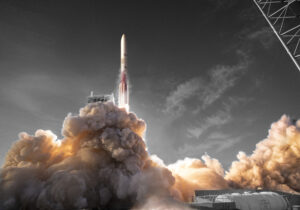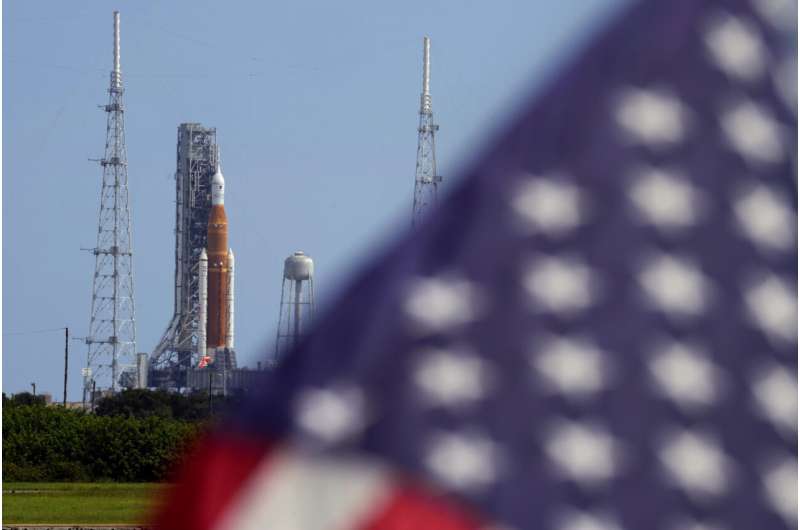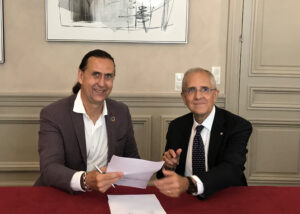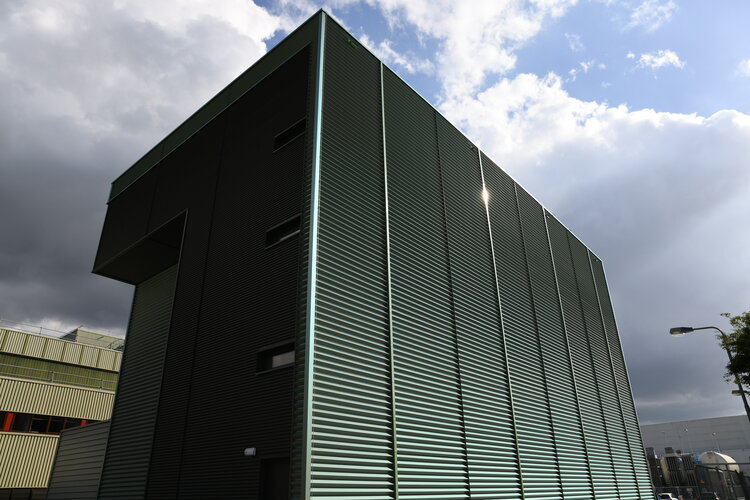New launch vehicles inch towards the pad
Thursday, 15 September 2022 07:24
Several new launch vehicles, some years behind their original schedules, are now expected to make their inaugural launches within the next year.
The post New launch vehicles inch towards the pad appeared first on SpaceNews.
A new space race? China adds urgency to US return to moon
Thursday, 15 September 2022 07:10
No sighting in northern Philippines of Chinese rocket debris
Thursday, 15 September 2022 07:04
Telespazio signs European distribution deal for NorthStar’s SSA data
Thursday, 15 September 2022 06:49
European space mission integrator Telespazio said Sept. 14 it has signed a deal to distribute Canadian startup NorthStar Earth & Space’s planned space domain awareness services.
The post Telespazio signs European distribution deal for NorthStar’s SSA data appeared first on SpaceNews.
ESA’s Test Centre expands
Thursday, 15 September 2022 06:49 Image:
ESA’s Test Centre expands
Image:
ESA’s Test Centre expands Wind drives geology on Mars these days
Wednesday, 14 September 2022 23:23
Pasadena CA (SPX) Sep 15, 2022
 A new paper based on exploration by the NASA's Curiosity Mars rover-and reviewed by an astronaut while she was on the International Space Station (ISS), in what may be a first for peer-reviewed science literature-describes how dramatically different geology on Mars works from that on Earth.
The paper is part of an ongoing attempt to understand the rock cycle on the Red Planet-that is, how
A new paper based on exploration by the NASA's Curiosity Mars rover-and reviewed by an astronaut while she was on the International Space Station (ISS), in what may be a first for peer-reviewed science literature-describes how dramatically different geology on Mars works from that on Earth.
The paper is part of an ongoing attempt to understand the rock cycle on the Red Planet-that is, how
 A new paper based on exploration by the NASA's Curiosity Mars rover-and reviewed by an astronaut while she was on the International Space Station (ISS), in what may be a first for peer-reviewed science literature-describes how dramatically different geology on Mars works from that on Earth.
The paper is part of an ongoing attempt to understand the rock cycle on the Red Planet-that is, how
A new paper based on exploration by the NASA's Curiosity Mars rover-and reviewed by an astronaut while she was on the International Space Station (ISS), in what may be a first for peer-reviewed science literature-describes how dramatically different geology on Mars works from that on Earth.
The paper is part of an ongoing attempt to understand the rock cycle on the Red Planet-that is, how Discovery Telescope plays key role in DART planetary defense test mission
Wednesday, 14 September 2022 23:23
Flagstaff AZ (SPX) Sep 15, 2022
 Within two weeks, the DART spacecraft will impact the asteroid moon Dimorphos as it completes the world's first planetary defense test mission. The success of the effort relies heavily on the Lowell Discovery Telescope, which scientists are using for both before- and after-impact observations.
The DART (Double Asteroid Redirection Test) mission is an outgrowth of ongoing interest in planet
Within two weeks, the DART spacecraft will impact the asteroid moon Dimorphos as it completes the world's first planetary defense test mission. The success of the effort relies heavily on the Lowell Discovery Telescope, which scientists are using for both before- and after-impact observations.
The DART (Double Asteroid Redirection Test) mission is an outgrowth of ongoing interest in planet
 Within two weeks, the DART spacecraft will impact the asteroid moon Dimorphos as it completes the world's first planetary defense test mission. The success of the effort relies heavily on the Lowell Discovery Telescope, which scientists are using for both before- and after-impact observations.
The DART (Double Asteroid Redirection Test) mission is an outgrowth of ongoing interest in planet
Within two weeks, the DART spacecraft will impact the asteroid moon Dimorphos as it completes the world's first planetary defense test mission. The success of the effort relies heavily on the Lowell Discovery Telescope, which scientists are using for both before- and after-impact observations.
The DART (Double Asteroid Redirection Test) mission is an outgrowth of ongoing interest in planet Simulation aids the search for the origin of cosmic rays
Wednesday, 14 September 2022 23:23
Bochum, Germany (SPX) Sep 15, 2022
 Cosmic rays seem to surround us everywhere. This is precisely what makes it difficult to find its sources. It would be helpful if we could trace their path through space. A new programme can help. An international research team has developed a computer programme that can simulate the transport of cosmic rays through space.
The researchers hope it will help them solve the mystery of the sou
Cosmic rays seem to surround us everywhere. This is precisely what makes it difficult to find its sources. It would be helpful if we could trace their path through space. A new programme can help. An international research team has developed a computer programme that can simulate the transport of cosmic rays through space.
The researchers hope it will help them solve the mystery of the sou
 Cosmic rays seem to surround us everywhere. This is precisely what makes it difficult to find its sources. It would be helpful if we could trace their path through space. A new programme can help. An international research team has developed a computer programme that can simulate the transport of cosmic rays through space.
The researchers hope it will help them solve the mystery of the sou
Cosmic rays seem to surround us everywhere. This is precisely what makes it difficult to find its sources. It would be helpful if we could trace their path through space. A new programme can help. An international research team has developed a computer programme that can simulate the transport of cosmic rays through space.
The researchers hope it will help them solve the mystery of the sou Satellite mobility ecosystem provider, Morpheus Space raises $28M in Series A
Wednesday, 14 September 2022 23:23
Los Angeles CA (SPX) Sep 15, 2022
 Morpheus Space, the leading provider of in-space mobility systems, has announced the close of a $28M Series A funding round led by space exclusive VC, Alpine Space Ventures. Alpine was joined by Morpheus Ventures, and existing investors - Vsquared Ventures, Lavrock Ventures, Airbus Ventures, In-Q-Tel, Pallas Ventures, and Techstars Ventures who returned from the company's Seed Round.
Morph
Morpheus Space, the leading provider of in-space mobility systems, has announced the close of a $28M Series A funding round led by space exclusive VC, Alpine Space Ventures. Alpine was joined by Morpheus Ventures, and existing investors - Vsquared Ventures, Lavrock Ventures, Airbus Ventures, In-Q-Tel, Pallas Ventures, and Techstars Ventures who returned from the company's Seed Round.
Morph
 Morpheus Space, the leading provider of in-space mobility systems, has announced the close of a $28M Series A funding round led by space exclusive VC, Alpine Space Ventures. Alpine was joined by Morpheus Ventures, and existing investors - Vsquared Ventures, Lavrock Ventures, Airbus Ventures, In-Q-Tel, Pallas Ventures, and Techstars Ventures who returned from the company's Seed Round.
Morph
Morpheus Space, the leading provider of in-space mobility systems, has announced the close of a $28M Series A funding round led by space exclusive VC, Alpine Space Ventures. Alpine was joined by Morpheus Ventures, and existing investors - Vsquared Ventures, Lavrock Ventures, Airbus Ventures, In-Q-Tel, Pallas Ventures, and Techstars Ventures who returned from the company's Seed Round.
Morph It's a planet: new evidence of baby planet in the making
Wednesday, 14 September 2022 23:23
Boston MA (SPX) Sep 15, 2022
 Astronomers agree that planets are born in protoplanetary disks - rings of dust and gas that surround young, newborn stars. While hundreds of these disks have been spotted throughout the universe, observations of actual planetary birth and formation have proved difficult within these environments.
Now, astronomers at the Center for Astrophysics | Harvard and Smithsonian have developed a ne
Astronomers agree that planets are born in protoplanetary disks - rings of dust and gas that surround young, newborn stars. While hundreds of these disks have been spotted throughout the universe, observations of actual planetary birth and formation have proved difficult within these environments.
Now, astronomers at the Center for Astrophysics | Harvard and Smithsonian have developed a ne
 Astronomers agree that planets are born in protoplanetary disks - rings of dust and gas that surround young, newborn stars. While hundreds of these disks have been spotted throughout the universe, observations of actual planetary birth and formation have proved difficult within these environments.
Now, astronomers at the Center for Astrophysics | Harvard and Smithsonian have developed a ne
Astronomers agree that planets are born in protoplanetary disks - rings of dust and gas that surround young, newborn stars. While hundreds of these disks have been spotted throughout the universe, observations of actual planetary birth and formation have proved difficult within these environments.
Now, astronomers at the Center for Astrophysics | Harvard and Smithsonian have developed a ne Sidus Space and Momentus execute MOU to better serve customers
Wednesday, 14 September 2022 23:23
Cape Canaveral FL (SPX) Sep 15, 2022
 Sidus Space, Inc. (NASDAQ:SIDU), a Space-as-a-Service satellite company focused on mission critical hardware manufacturing; multi-disciplinary engineering services; satellite design, production, launch planning, mission operations; and in-orbit support, has signed a memorandum of understanding ("MOU") with Momentus Inc.(NASDAQ: MNTS) to explore launching its LizzieSat satellites utilizing Moment
Sidus Space, Inc. (NASDAQ:SIDU), a Space-as-a-Service satellite company focused on mission critical hardware manufacturing; multi-disciplinary engineering services; satellite design, production, launch planning, mission operations; and in-orbit support, has signed a memorandum of understanding ("MOU") with Momentus Inc.(NASDAQ: MNTS) to explore launching its LizzieSat satellites utilizing Moment
 Sidus Space, Inc. (NASDAQ:SIDU), a Space-as-a-Service satellite company focused on mission critical hardware manufacturing; multi-disciplinary engineering services; satellite design, production, launch planning, mission operations; and in-orbit support, has signed a memorandum of understanding ("MOU") with Momentus Inc.(NASDAQ: MNTS) to explore launching its LizzieSat satellites utilizing Moment
Sidus Space, Inc. (NASDAQ:SIDU), a Space-as-a-Service satellite company focused on mission critical hardware manufacturing; multi-disciplinary engineering services; satellite design, production, launch planning, mission operations; and in-orbit support, has signed a memorandum of understanding ("MOU") with Momentus Inc.(NASDAQ: MNTS) to explore launching its LizzieSat satellites utilizing Moment OneWeb and Arianespace signed an agreement following the suspension of the launches
Wednesday, 14 September 2022 23:23
Paris, France (SPX) Sep 15, 2022
 Following the suspension of OneWeb's launches in March 2022, OneWeb and Arianespace have reached an agreement pursuant to which performance of the Launch Services Agreement may be resumed in the future. The terms of the settlement are confidential.
Arianespace is supporting OneWeb on its upcoming launches; including the performance of Dispenser Supply Services for two launches to be perfor
Following the suspension of OneWeb's launches in March 2022, OneWeb and Arianespace have reached an agreement pursuant to which performance of the Launch Services Agreement may be resumed in the future. The terms of the settlement are confidential.
Arianespace is supporting OneWeb on its upcoming launches; including the performance of Dispenser Supply Services for two launches to be perfor
 Following the suspension of OneWeb's launches in March 2022, OneWeb and Arianespace have reached an agreement pursuant to which performance of the Launch Services Agreement may be resumed in the future. The terms of the settlement are confidential.
Arianespace is supporting OneWeb on its upcoming launches; including the performance of Dispenser Supply Services for two launches to be perfor
Following the suspension of OneWeb's launches in March 2022, OneWeb and Arianespace have reached an agreement pursuant to which performance of the Launch Services Agreement may be resumed in the future. The terms of the settlement are confidential.
Arianespace is supporting OneWeb on its upcoming launches; including the performance of Dispenser Supply Services for two launches to be perfor KTSAT contracts with Satconsult to provide expert oversight of satellite construction
Wednesday, 14 September 2022 23:23
Paris, France (SPX) Sep 15, 2022
 Euroconsult has announced that its affiliate, Southern Aerospace and Telecom Consulting (Satconsult) has contracted with KTSAT to provide expert oversight throughout the build of Koreasat 6A satellite. The contract marks the third time that KTSAT will put its trust in Satconsult's depth of expertise to support the monitoring and control of the manufacturing process and advise on best practices f
Euroconsult has announced that its affiliate, Southern Aerospace and Telecom Consulting (Satconsult) has contracted with KTSAT to provide expert oversight throughout the build of Koreasat 6A satellite. The contract marks the third time that KTSAT will put its trust in Satconsult's depth of expertise to support the monitoring and control of the manufacturing process and advise on best practices f
 Euroconsult has announced that its affiliate, Southern Aerospace and Telecom Consulting (Satconsult) has contracted with KTSAT to provide expert oversight throughout the build of Koreasat 6A satellite. The contract marks the third time that KTSAT will put its trust in Satconsult's depth of expertise to support the monitoring and control of the manufacturing process and advise on best practices f
Euroconsult has announced that its affiliate, Southern Aerospace and Telecom Consulting (Satconsult) has contracted with KTSAT to provide expert oversight throughout the build of Koreasat 6A satellite. The contract marks the third time that KTSAT will put its trust in Satconsult's depth of expertise to support the monitoring and control of the manufacturing process and advise on best practices f China launches Zhongxing-1E satellite
Wednesday, 14 September 2022 23:23
Wenchang, China (SPX) Sep 15, 2022
 China successfully sent a new satellite into space from the Wenchang Spacecraft Launch Site in the southern island province of Hainan on Tuesday.
The satellite, Zhongxing-1E, was launched at 9:18 p.m. (Beijing Time) by a modified version of the Long March-7 carrier rocket and entered the planned orbit successfully. It will provide high-quality voice, data, radio and television transmission
China successfully sent a new satellite into space from the Wenchang Spacecraft Launch Site in the southern island province of Hainan on Tuesday.
The satellite, Zhongxing-1E, was launched at 9:18 p.m. (Beijing Time) by a modified version of the Long March-7 carrier rocket and entered the planned orbit successfully. It will provide high-quality voice, data, radio and television transmission
 China successfully sent a new satellite into space from the Wenchang Spacecraft Launch Site in the southern island province of Hainan on Tuesday.
The satellite, Zhongxing-1E, was launched at 9:18 p.m. (Beijing Time) by a modified version of the Long March-7 carrier rocket and entered the planned orbit successfully. It will provide high-quality voice, data, radio and television transmission
China successfully sent a new satellite into space from the Wenchang Spacecraft Launch Site in the southern island province of Hainan on Tuesday.
The satellite, Zhongxing-1E, was launched at 9:18 p.m. (Beijing Time) by a modified version of the Long March-7 carrier rocket and entered the planned orbit successfully. It will provide high-quality voice, data, radio and television transmission Beyond Gravity lays foundation for next growth phase
Wednesday, 14 September 2022 23:23
Zurich, Switzerland (SPX) Sep 15, 2022
 Beyond Gravity ignites the next stage on its way to privatization: In addition to Launchers and Satellites, Lithography is established as a third division. The business with apertures and stabilizers for the production of microchips has grown strongly in recent years and is showing promising development. Furthermore, the support functions in the company will be reorganized into Finance, HR and C
Beyond Gravity ignites the next stage on its way to privatization: In addition to Launchers and Satellites, Lithography is established as a third division. The business with apertures and stabilizers for the production of microchips has grown strongly in recent years and is showing promising development. Furthermore, the support functions in the company will be reorganized into Finance, HR and C
 Beyond Gravity ignites the next stage on its way to privatization: In addition to Launchers and Satellites, Lithography is established as a third division. The business with apertures and stabilizers for the production of microchips has grown strongly in recent years and is showing promising development. Furthermore, the support functions in the company will be reorganized into Finance, HR and C
Beyond Gravity ignites the next stage on its way to privatization: In addition to Launchers and Satellites, Lithography is established as a third division. The business with apertures and stabilizers for the production of microchips has grown strongly in recent years and is showing promising development. Furthermore, the support functions in the company will be reorganized into Finance, HR and C 